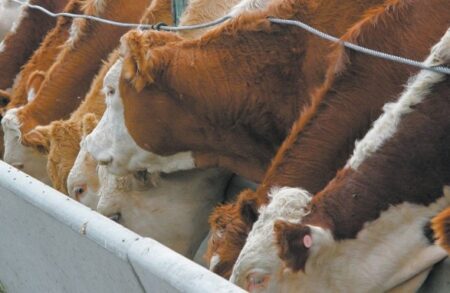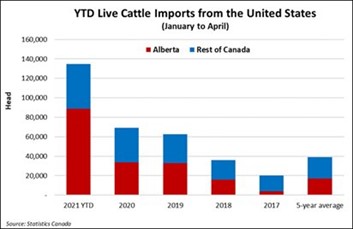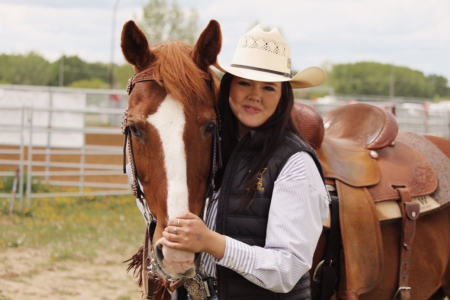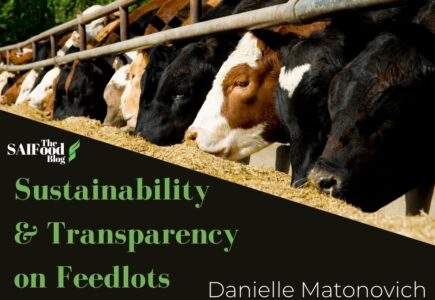Why Feedlots are a Sustainable and Economically Stable Choice to Produce Meat
By Danielle Matonovich, University of Saskatchewan student

Source: (Bezan, 2021)
What are feedlots?
Feedlots are the final stage in beef production. This is the most intensive stage, where the goal is to ensure high-quality meat for the consumers, while maintaining a sustainable and financially wise approach. Feedlots focus on growth and weight gain, while eliminating the need for cattle to forage for food.
Canada’s first feedlot, Pound-Maker, was established in 1970 as an alternative market for local farmers’ grain. It started as a 2,500-head feedlot with 50 local farmers as shareholders. Since then, there has been a significant increase in feedlots across Canada, with Alberta reporting a substantial volume of 156 finishing feedlots.
Feedlots’ Role in Environmental Sustainability
An important factor in ensuring production sustainability is to study the environmental footprint of all products produced. When discussing the environmental footprint of feedlots, past studies have found Over 78% of the methane emissions occurred in the cow-calf sector (not the feedlot), because the breeding herd spends nearly its whole life consuming forage-based diets that produce more methane than grain-based diets do. The emission factor for feedlot steers and heifers is about half the emission factor for cows compared to forage-based production, where the emission factors for steers and heifers were 70% and 80%of the mature cow, respectively. This procedure also produced emission factors for feedlot animals that were roughly two thirds of those for forage-based production. In addition to reduced methane, feedlots reduce overgrazing of the land. By sending cattle to feedlots, the grasslands can regrow and replenish their resources, i.e., minerals in the land and water.
Feedlots Through an Economic Perspective
Feedlots play a big role in minimizing food waste. Most feedlots repurpose food from supermarkets which would otherwise will be thrown away such as food deemed unfit for human consumption or close to its expiry date. Buying these “end of the line products” from both supermarkets and producers allows feedlots to keep their production costs low and ensures higher revenue .
Jason Wood, livestock market analyst with Alberta Agriculture and Forestry, reported “the demand for cattle has turned Canada into a net importer of feeder cattle” in recent years. In the 2021 period (January to April), 134,660 head were imported across Canada from the U.S., an increase of 95% from 2020. In this same period, Alberta cattle imports from the U.S. were 88,870 head, an increase of 165% from 2019.

Source: Farms.com
This is important information to consider when discussing feedlots given Canada’s beef production in the past few years has helped drive economic growth. 2018-2020 Statistics Canada and Canfax averages announce that beef production contributes approximately $21.8 billion to Canada’s GDP. The strong relationship Canada has built by importing cattle to our feedlots has allowed Canada’s global reputation for beef production to be enforced, thereby creating greater beef export opportunities.
Why are feedlots given a negative connotation?
When feedlots are mentioned, consumers tend to think of a handful of concerns, including a concern for animal welfare (i.e., illness, stress, inhumane treatment, small pens, etc.). While acknowledging the concern, it is important to provide feedlot facts, and we need to discuss the Canadian Feedlot Animal Care Assessment Program. This program is an objective, science-based, and practical animal health and welfare audit, which ensures comprehensive care in Canada specifically for confined beef cattle feedlots. This audit has been certified and recognized by many organizations, including PAACO (Professional Animal Auditor Certified Organization), NFACC (National Farm Animal Care Council), and CRSB (Canadian Roundtable of Sustainable Beef Production).
Growing Consumer Trust in Feedlots
Agriculture and Agri-Food Canada’s main goal is to ensure that consumers trust where their food is coming from. Farmers, producers, and AAFC understand how crucial it is to know where and who your food is coming from, what it has gone through, and how it’s been produced. Because of this, their goal is to ensure there is transparency between the agriculture sector and consumers. In addition to the Canadian Feedlot Animal Care Assessment Program, AAFC Minister, Marie-Claude Bibeau announced an investment of up to $3.6 million for projects that will help the beef industry grow, including helping to increase public trust in beef products.
Looking Forward
Looking A producer’s goal is to feed the country while maintaining an ethical and sustainable production system. Although feedlots can be a controversial topic, my hope is this article gives insight into the sustainability of feedlots and the goal of low-cost production.
References
Agriculture and Agri-Food Canada. (2022, April 25). Driving economic growth by advancing Canada’s global reputation for top-quality beef. Canada.ca. Retrieved September 29, 2022, from https://www.canada.ca/en/agriculture-agri-food/news/2022/04/driving-economic-growth-by-advancing-canadas-global-reputation-for-top-quality-beef.html
Alberta Cattle Feeders’ Association. (2021). Feedlot 101. Alberta Cattle Feeders’ Association. (2020, July 21). Retrieved September 29, 2022, from https://cattlefeeders.ca/feedlot-101/
Bezan, M. (2021, September 30). Feedlot Food Waste Management finds positive reaction. The Western Producer. Retrieved September 29, 2022, from https://www.producer.com/livestock/feedlot-food-waste-management-finds-positive-reaction/
Farms.com. (2021, July 14). Update on Cattle Imports and Exports. Farms.com. Retrieved September 29, 2022, from https://www.farms.com/news/update-on-cattle-imports-and-exports-169574.aspx
Glen.B. (2021) Feedlot growth overtakes herd size | the western producer. Retrieved September 29, 2022, from https://www.producer.com/livestock/feedlot-growth-overtakes-herd-size/
Lupo, C. D., Clay, D. E., Benning, J. L., & Stone, J. J. (2013). Life-cycle assessment of the beef cattle production system for the northern great plains, USA. Journal of environmental quality, 42(5), 1386–1394. https://doi.org/10.2134/jeq2013.03.0101
McAllister, T. (2022). Environmental Footprint of Beef Production. Beef Cattle Research Council. https://www.beefresearch.ca/topics/environmental-footprint-of-beef-production/
National Cattle Feeder’s Association. (2022). Canadian Feedlot Animal Care Assessment Program: National Cattle Feeder’s Association. National Cattle Feeder’s Association | The voice of Canadian cattle feeders. (2022, May 2). Retrieved September 29, 2022, from https://nationalcattlefeeders.ca/feedlot/
Pound-Maker. (n.d.). About Us. pound. Retrieved October 11, 2022, from https://pound-maker.ca/pages/about-us#:~:text=Canada’s%20First%20Integrated%20Feedlot%2FEthanol,local%20area%20farmers%20as%20shareholders
X.P.C. Vergé, J.A. Dyer, R.L. Desjardins, D. Worth, Greenhouse gas emissions from the Canadian beef industry, Agricultural Systems, Volume 98, Issue 2, 2008, Pages 126-134, https://www.sciencedirect.com/science/article/pii/S0308521X08000590
Biography

Danielle Matonovich is 19 years old and from Grandora, Saskatchewan. Danielle found a love for cattle through her involvement in 4H. Danielle has been growing her commercial cattle herd for a couple of years and is excited to watch it grow. She is an active member of the U of S Rodeo Team and enjoys her time with her horses on the rodeo circuit. Danielle is currently working towards a Bachelor of Science in Agribusiness at the University of Saskatchewan, with plans to aid in cow calf productions.


